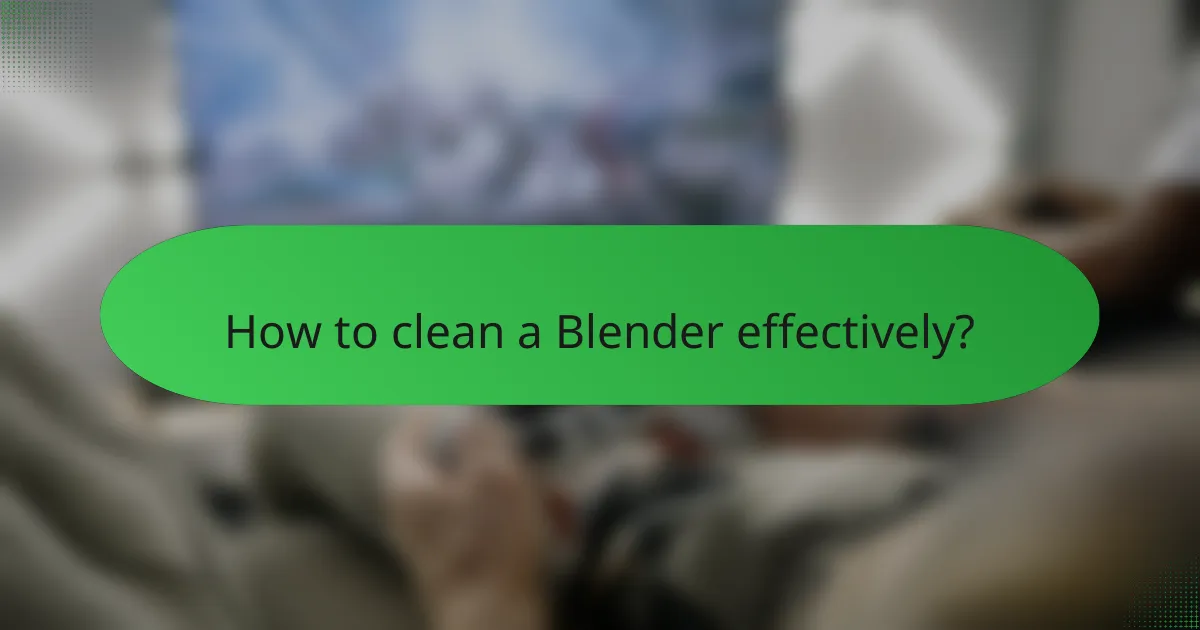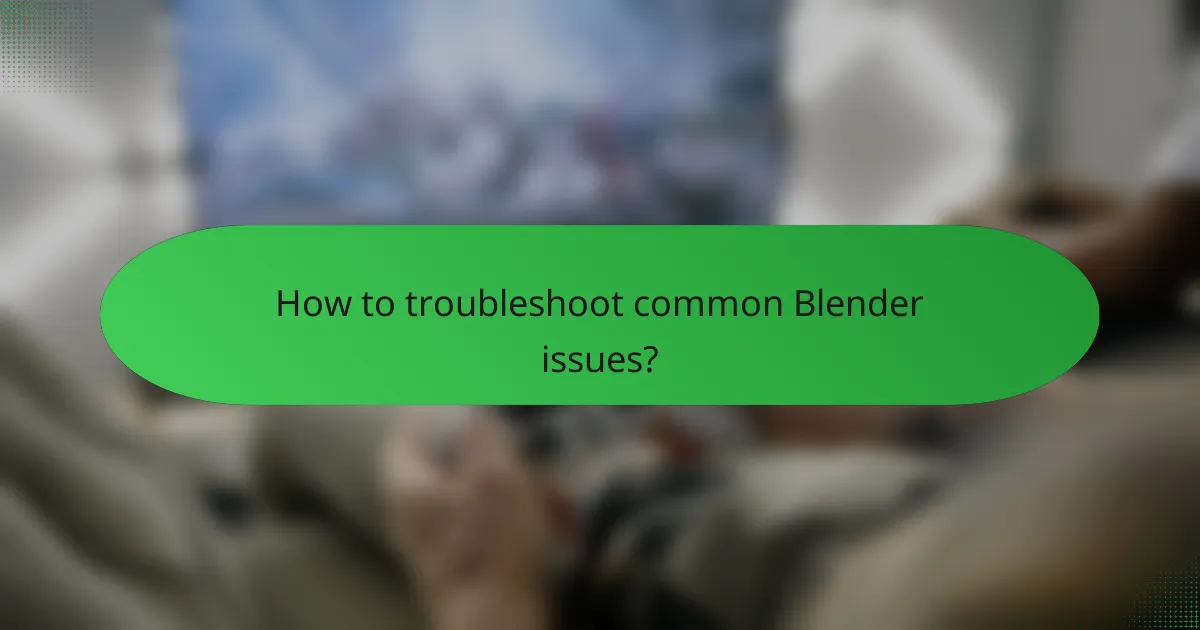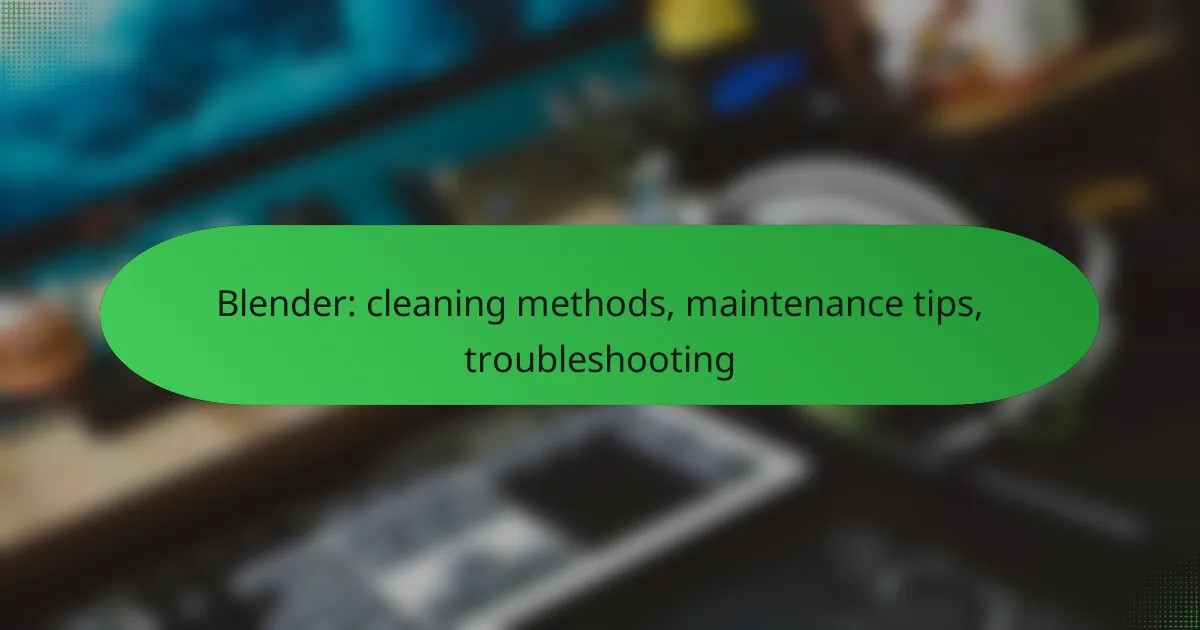Proper cleaning and maintenance of your blender are crucial for ensuring its longevity and performance. By employing effective cleaning methods and regularly inspecting key components, you can keep your appliance in top shape. Additionally, knowing how to troubleshoot common issues will help you address problems quickly and efficiently.

How to clean a Blender effectively?
Cleaning a blender effectively involves using the right methods to ensure all residues are removed without damaging the appliance. Regular maintenance and proper cleaning techniques can prolong the lifespan of your blender and keep it in optimal working condition.
Use warm soapy water
Using warm soapy water is one of the simplest and most effective methods for cleaning a blender. Fill the blender jar halfway with warm water and add a few drops of dish soap. Blend on high for about 30 seconds, then rinse thoroughly.
This method helps to dislodge food particles and grease, making it easier to clean the blades and interior surfaces. Always ensure the blender is unplugged before cleaning to avoid accidents.
Utilize a blender cleaning brush
A blender cleaning brush can reach areas that are difficult to clean with a sponge or cloth. These brushes are designed to fit into the jar and around the blades, ensuring a thorough clean. Use the brush with warm soapy water for best results.
When selecting a cleaning brush, look for one with soft bristles to avoid scratching the blender’s surfaces. Regular use of a cleaning brush can help maintain hygiene and prevent buildup of residues.
Run a self-cleaning cycle
If your blender has a self-cleaning feature, utilize it for a hassle-free cleaning experience. Simply add water and a drop of dish soap, then activate the self-cleaning function. This cycle typically takes a few minutes and effectively cleans the blender without much effort.
Self-cleaning cycles are particularly useful for blenders with complex designs, as they can reach all the nooks and crannies. Always refer to the manufacturer’s instructions for specific guidance on using this feature.
Use vinegar and baking soda solution
A mixture of vinegar and baking soda can effectively tackle tough stains and odors in your blender. Combine equal parts of vinegar and baking soda in the blender jar, let it fizz for a few moments, then add warm water and blend for about 30 seconds.
This natural cleaning solution is safe and effective, making it a great alternative to chemical cleaners. Rinse thoroughly after use to ensure no residue remains.
Rinse and dry thoroughly
After cleaning your blender, it’s crucial to rinse it thoroughly to remove any soap or cleaning solution. Fill the jar with clean water, blend for a few seconds, and then pour out the water.
Once rinsed, dry the blender parts completely before reassembling. This prevents moisture buildup, which can lead to mold or unpleasant odors. Use a clean towel or let the parts air dry on a drying rack for best results.

What are the best maintenance tips for a Blender?
To keep your blender in optimal working condition, regular maintenance is essential. Key practices include checking the blade assembly, inspecting seals, cleaning the motor base, and proper storage.
Regularly check the blade assembly
Inspecting the blade assembly is crucial for maintaining blending efficiency. Look for any signs of dullness or damage, as this can affect performance. If the blades are not cutting effectively, consider sharpening or replacing them.
Ensure that the blade assembly is securely attached to the jar. Loose blades can lead to leaks and inefficient blending. Tighten the assembly as needed to prevent these issues.
Inspect and replace seals as needed
Seals play a vital role in preventing leaks during operation. Regularly check the rubber or silicone seals for wear and tear. If you notice cracks or brittleness, it’s time to replace them to maintain a leak-proof blender.
Replacement seals are often available from the manufacturer or third-party suppliers. Be sure to choose the correct size and type to ensure compatibility with your blender model.
Keep the motor base clean
The motor base of your blender should be kept clean to prevent dust and food particles from affecting its performance. Wipe it down with a damp cloth after each use, avoiding excess moisture around electrical components.
For deeper cleaning, unplug the blender and use a soft brush to remove debris from vents and crevices. This helps maintain airflow and prevents overheating during use.
Store the blender properly
Proper storage extends the life of your blender. Always store it in a dry place, away from direct sunlight and humidity, which can damage components. If possible, keep the blender upright to avoid any potential leaks from the jar.
Consider using a protective cover if you store it in a cabinet or on the countertop. This can help prevent dust accumulation and scratches, keeping your blender looking new and functioning well.

How to troubleshoot common Blender issues?
Troubleshooting common Blender issues involves identifying the problem and applying specific solutions. Many issues can be resolved with simple checks or adjustments, ensuring your blender operates efficiently.
Blender not turning on
If your blender is not turning on, first check if it is properly plugged into a functioning outlet. Inspect the power cord for any visible damage, and ensure the base is securely connected to the jar.
Sometimes, the safety mechanism may prevent operation if the jar is not seated correctly. Make sure all components are aligned and locked in place before trying to power it on again.
Blades not spinning
When the blades are not spinning, it could be due to a jam or obstruction. Check for any food particles or ice that may be stuck in the blade assembly. Remove the jar and clean the blades thoroughly.
Another possibility is that the motor is overheated. If you’ve been using the blender for an extended period, allow it to cool down for several minutes before trying again.
Unusual noises during operation
Unusual noises can indicate a problem with the motor or blades. If you hear grinding or rattling sounds, check for loose parts or debris caught in the blades. Ensure that the jar is properly secured to the base.
In some cases, a worn-out motor may produce strange sounds. If the noise persists after checking for obstructions, consider consulting a professional for repairs or replacement.
Leaking from the base
Leaking from the base of the blender often results from a worn or damaged seal. Inspect the gasket or O-ring for any signs of wear and replace it if necessary to prevent leaks.
Additionally, overfilling the jar can cause liquid to escape during blending. Always adhere to the maximum fill line to avoid spills and ensure proper operation.

What are the common cleaning mistakes with Blenders?
Common cleaning mistakes with blenders can lead to damage or ineffective cleaning. Understanding these pitfalls helps maintain your blender’s performance and longevity.
Using abrasive cleaners
Abrasive cleaners can scratch and damage the surfaces of your blender, particularly the plastic components. Instead, opt for gentle dish soap and warm water to clean the blender jar and lid.
For stubborn stains, consider using a mixture of baking soda and water, which is effective yet safe for most materials. Always check the manufacturer’s guidelines for recommended cleaning products.
Soaking the motor base
Soaking the motor base of a blender can lead to electrical damage and malfunction. The motor base should only be wiped down with a damp cloth to avoid moisture entering the electrical components.
If food particles are stuck, use a slightly damp cloth with mild soap, ensuring no liquid seeps into the base. Regularly clean the base to prevent buildup without soaking it.
Neglecting to clean the lid
The lid of a blender often traps food particles and residue, which can lead to unpleasant odors and contamination. Make it a habit to clean the lid thoroughly after each use.
Remove the lid and wash it with warm, soapy water, paying special attention to any grooves or seals. For a deeper clean, consider using a small brush to reach difficult areas.

How to choose the right Blender for cleaning ease?
Selecting a blender that is easy to clean can save you time and effort in the kitchen. Look for features that simplify maintenance, ensuring that your blending experience is both efficient and hassle-free.
Look for dishwasher-safe components
Choosing a blender with dishwasher-safe parts can significantly reduce your cleaning time. Most modern blenders have containers and lids that can withstand the dishwasher’s heat and pressure, making cleanup straightforward.
When shopping, check the product specifications to confirm which components are dishwasher-safe. This feature allows you to simply place the parts in the dishwasher after use, ensuring they are sanitized and ready for the next blending task.
Consider self-cleaning features
Some blenders come with self-cleaning functions that can make maintenance even easier. These blenders allow you to add water and a drop of dish soap, then run the blender to clean the interior without disassembling it.
While self-cleaning can be a convenient option, ensure that the model you choose has a reliable self-cleaning mechanism. This can save you from the hassle of scrubbing and can be particularly useful for sticky or thick mixtures.
Check for removable blades
Blenders with removable blades can simplify the cleaning process significantly. Being able to detach the blades allows for thorough cleaning, ensuring that no food particles are left behind.
When evaluating blenders, look for models that offer easy blade removal. This feature can help prevent buildup and make maintenance more efficient, especially if you frequently blend tough ingredients.
